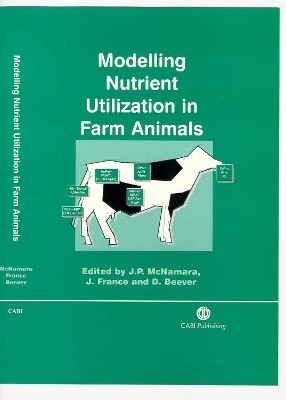
Modelling Nutrient Utilization in Farm Animals
CABI Publishing (Verlag)
978-0-85199-449-9 (ISBN)
- Titel z.Zt. nicht lieferbar
- Versandkostenfrei innerhalb Deutschlands
- Auch auf Rechnung
- Verfügbarkeit in der Filiale vor Ort prüfen
- Artikel merken
This book describes current research in modelling nutrient use in farm animals, from cellular to ecosystem level. The chapters are developed from papers presented at a satellite meeting of the 9th International Symposium on Ruminant Physiology, held in South Africa in October 1999. - Excellent papers from a top list of contributors - Editors of great reputation - Covers the current topics of interest
James France
1: Introduction: History and Future of Modelling Nutrient Utilization in Farm Animals, R L Baldwin 2: Session 1: Ruminal Metabolism. Session Chairs: D E Beever, J France and J P McNamara 3: The role of thermodynamics in controlling rumen metabolism, R A Kohn & R C Boston 4: Modelling lipid metabolism in the rumen, J Dijkstra et al. 5: Towards a more accurate representation of fermentation in mathematical models of the rumen, B N Nagorcka et al. 6: Simple allometric models to predict rumen feed passage rate in domestic ruminants, A Cannas and P J Van Soest 7: Ruminal metabolism of buffer-soluble proteins, peptides and amino acids in vitro, P Udén 8: Session 2: Absorption and Metabolism. Session Chair: R A Kohn 9: Models to interpret degradation profiles obtained from in vitro and in situ incubation of ruminant feeds, S López et al. 10: Modelling production and portal appearance of volatile fatty acids in dairy cows, A Bannink et al. 11: Modelling energy expenditure in pigs, J Van Milgen and J Noblet 12: Aspects of modelling kidney dynamics, B Robson and M Vlieg 13: Evaluation of a representation of the limiting amino acid theory for milk protein synthesis, M D Hanigan et al. 14: Multiple entry urea kinetic model: effects of incomplete urine collection, G Zuur et al. 15: Session 3: Growth and Development. Session Chair: D Sauvant 16: Evaluation of a growth model of preruminant calves and modifications to simulate short-term responses to changes in protein intake, W J J Gerrits et al. 17: Simulation of the development of adipose tissue in beef cattle, R D Sainz and E. Hasting 18: A simple nutrient based production model for the growing pig, S Boisen 19: Second generation dynamic cattle growth and composition models, J W Oltjen et al 20: Modelling interactions between cow milk yield and growth of its suckling calf, F Blanc, J Agabriel, and P Sabatier 21: A mechanistic dynamic model of beef cattle growth, T Hoch and J Agabriel 22: Session 4: Ruminant Production in Various Situations. Session Chair: R C Boston 23: Modelling nutrient utilization in growing cattle subjected to short or long periods of moderate to severe undernutrition, G Q Witten, and F D Richardson 24: An integrated cattle and crop production model to develop whole-farm nutrient management plans, T P Tylutki and D G Fox 25: Modelling nutrient utilization by livestock grazing semi-arid rangeland, F D Richardson et al. 26: Using the Cornell Net Carbohydrate and Protein System Model to evaluate the effects of variation in maize silage quality on a dairy farm, T P Tylutki et al. 27: Session 5: Nutrient Metabolism. Session Chair: J Dijkstra 28: Challenge and improvement of a model of post-absorptive metabolism in dairy cattle, J P McNamara and J G Phillips 29: A rodent model of protein turnover to determine protein synthesis, amino acid channelling and recycling rates in tissues, H A Johnson et al. 30: Modelling relationships between homeorhetic and homeostatic control of metabolism. Application to growing pigs, D Sauvant and P Lovatto 31: Model for the interpretation of the energy metabolism in farm animals, A Chudy 32: Linear models of nitrogen utilization in dairy cows, E Kebreab et al. 33: Isotope dilution models for partitioning amino acid uptake by the liver, mammary gland and hindlimb tissues of ruminants, L A Crompton et al. 34: Session 6: Production and Evaluation Models. Session Chair: J P McNamara 35: The conversion of a scientific model describing dairy cow nutrition and production to an industry tool: The CPM Dairy Project, R Boston et al. 36: The utilization of prediction models to optimize farm animal production systems. The case of a growing pig model, P Jean dit Bailleul et al. 37: A pig model for feed evaluation, A Danfaer
| Erscheint lt. Verlag | 22.9.2000 |
|---|---|
| Co-Autor | David Beever |
| Verlagsort | Wallingford |
| Sprache | englisch |
| Maße | 156 x 234 mm |
| Themenwelt | Mathematik / Informatik ► Mathematik ► Angewandte Mathematik |
| Naturwissenschaften ► Biologie ► Zoologie | |
| Veterinärmedizin ► Allgemein ► Tierernährung / Tierhaltung / Tierzucht | |
| Weitere Fachgebiete ► Land- / Forstwirtschaft / Fischerei | |
| ISBN-10 | 0-85199-449-0 / 0851994490 |
| ISBN-13 | 978-0-85199-449-9 / 9780851994499 |
| Zustand | Neuware |
| Haben Sie eine Frage zum Produkt? |
aus dem Bereich


